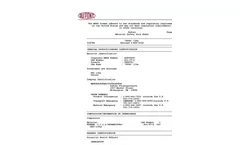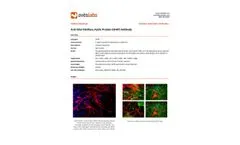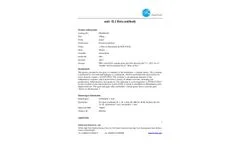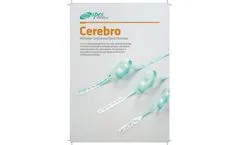central-nervous-system Downloads
7 downloads found
ADDITIONAL HEALTH EFFECTS ETHANE, 1,1,1,2-TETRAFLUORO- Increased susceptibility to the effects of this material may be observed in persons with pre-existing disease of the: central nervous system, cardiovascular system. Carcinogenicity Information None of the components present in ...
Human Glial Fibrillary Acidic Protein (GFAP) is a 49,749 dalton protein (432 amino acids) expressed by astrocytes of the central nervous system. GFAP is an intermediate filament protein and acts as an intra-cellular structural component of the astrocytic cytoskeleton. During embryonic and fetal life, GFAP is also expressed by radial glial cells of the CNS. Rare mutations of the GFAP gene in ...
The cerebrospinal fluid (CSF) surrounds the brain and the spinal cord. Its primary function is physical protection of the central nervous system (CNS). The fluid spaces surround the ventricle in the brain and the subarachnoid space (inner and outer fluid spaces). Approximately 80 to 90 % of the cerebrospinal fluid is formed in the choroid plexus from the blood. Every day 500 ml of fluid are ...
The protein encoded by this gene is a member of the interleukin 1 cytokine family. This cytokine is produced by activated macrophages as a proprotein, which is proteolytically processed to its active form by caspase 1 (CASP1/ICE). This cytokine is an important mediator of the inflammatory response, and is involved in a variety of cellular activities, including cell proliferation, differentiation, ...
Intracranial surface electrodes or subdural cortical electrodes are used for stimulation and recording of central nervous system signals. Intracranial monitoring is used to identify and map functional areas of the brain during pre- and post-surgical phases and during surgical removal of brain tumors. The surface of the intracranial electrodes are multipolar arrays of electrodes (GRID or STRIP) ...
Indications: Injuries to the central nervous system (cerebral palsy, trauma, etc.). Spinal cord injuries affecting the upper limbs (poliomyelitis, amyotrophic lateral sclerosis, etc.). Injuries to the brachial plexus. Traumatic injuries affecting the upper limbs. ...
Providing risk-assessment for hereditary cancer syndromes for patients and their families. xG+ (extended hereditary cancers): Covers genes associated with multiple hereditary cancer types, including common hereditary cancers (breast, ovarian, colorectal, endometrial, prostate, pancreatic) and others (renal/urinary tract, gastric, melanoma, thyroid, endocrine, sarcomas, central nervous system, ...
ByTempus







